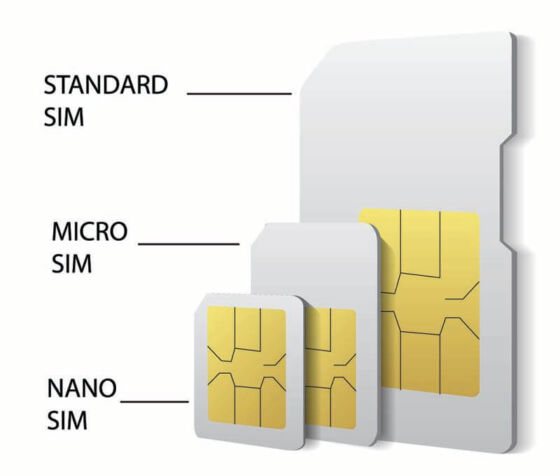Key points
- Physical SIM cards come in standard, micro and nano SIM sizes.
- Some devices also use an eSIM, which doesn’t require a physical card.
- Smartphones, tablets, smartwatches, modems and hotspots may all use a SIM card.
If you’ve got a phone, then you’ll need a SIM – whether that be a physical SIM card or an eSIM. However, it can be confusing knowing which SIM card size or type you need for your phone.
In this article, Canstar Blue compares the different SIM card sizes and which may be best for you.
On this page:
What are the different SIM card sizes?
As smartphone technology advances, SIM card sizes have reduced. This shift is because the space inside a phone is valuable: by reducing the size of SIM cards, manufacturers can make room for more important parts – such as bigger batteries or more powerful processors.
However, larger SIM cards are still being used in some smartphone models, as well as devices such as modems or hotspots. Knowing the types of SIM cards available will ensure you’re getting the right card for your device.
The three different SIM card sizes in Australia and elsewhere are:
- Mini (also known as standard)
- Micro
- Nano

Standard SIM cards
Standard SIM cards are the biggest SIM you’ll see these days, and are mostly used in larger devices which are more concerned with ease of use than saving space.
They’re found in budget mobile phones and other devices with thicker profiles, especially older 3G devices or feature phones. The standard SIM card has been around since the late 1990s, and measures 25mm x 15mm – about the size of your top thumb joint.
Micro SIM cards
Micro SIM cards are probably the second-most common SIM card size in use today, and were introduced in 2003. Roughly half the size of a standard SIM at 15mm x 12mm (but using the same-sized circuit), micro SIMs are used in many older Android mobile phones, as well as the earlier generations of iPhones.
In recent years, micro SIM cards have started to be phased out in favour of nano SIMs.
Nano SIM cards
Originating with the iPhone 5 in 2012, the nano SIM size is now the standard size for new smartphones. The nano SIM is almost all circuit with hardly any plastic bezel, measuring just 12.3mm x 8.9mm. As modern smartphones become thinner, a nano SIM allows more space in your device for bigger hardware.
SIM card types compared
| SIM card type | Length (mm) | Width (mm) | Height (mm) |
|---|---|---|---|
| Mini | 25.00 | 15.00 | 0.76 |
| Micro | 15.00 | 12.00 | 0.76 |
| Nano | 12.30 | 8.80 | 0.67 |
What’s the difference between SIM card sizes?
Apart from the physical size of the SIM cards, there isn’t any difference between standard, micro and nano SIM cards. Each is capable of doing the same job, but are simply different sizes to fit into different phone models.
What is an eSIM?
While standard, micro and nano SIMs are all physical cards that you’ll need to manually insert into your phone, many telcos are now offering a new option: eSIM.
An eSIM, or embedded SIM, is a digital SIM that is built directly into your device, replacing the need for a physical SIM card. Because eSIMs are built into your phone, they take up much less room than traditional SIM cards.
While eSIMs in phones are built-in, they still require activation. To get your eSIM up and running, you’ll need to buy an eSIM-compatible mobile plan and follow the onscreen prompts. Note that you may need to download a mobile provider’s app to activate your eSIM.
Compare SIM-only phone plans
Here is a selection of postpaid plans from Canstar Blue’s database with a minimum of 20GB of data, listed in order of standard cost, lowest to highest, then by data allowance, largest to smallest. Try using our mobile phone plan comparison tool to see a wide range of plans from other providers. This table includes products with links to referral partners.
Here is a selection of prepaid plans from Canstar Blue’s database with a minimum of 10GB of data each month, listed in order of standard cost, lowest to highest, then by data allowance, largest to smallest. If you want to compare a larger range of offers from other providers, use our phone plan comparison tool. This table includes products with links to referral partners.
What size SIM card do I need?
The SIM card you will need depends entirely on your mobile phone. You can find out the size of your phone’s SIM card in several ways, including:
- Checking your phone’s user manual.
- Going to the manufacturer’s website and checking the tech specs of your phone.
- Pulling out the SIM card holder and measuring it.
- Comparing it to your existing SIM card.
What is a 3-in-1 SIM card?
Currently, just about all mobile service providers issue customers with a 3-in-1 SIM card (also known as a combi SIM, universal SIM or triple-cut SIM). The micro and nano SIM sizes are contained within the standard SIM – all you need to do is pop out the one that fits your device.
Related articles:
What size SIM card does a smartwatch use?
Many smartwatches are able to make and answer calls. Originally, most wearables needed to be paired with your smartphone via Bluetooth to call or text, however newer models can work independently of your phone via a SIM card.
While some older models come with a nano SIM card slot, most modern smartwatches are able to use eSIMs. An eSIM can also allow you to share your phone’s mobile number with the SIM on your smartwatch, so you can use the one mobile phone plan across both devices.
What size SIM card does a tablet use?
If your tablet is WiFi-only, it doesn’t require a SIM card; instead, it will just connect to your home, work or public WiFi network. However, tablets that have cellular connectivity (sometimes called 4G or 5G connectivity) can use a data-only SIM card to access the internet when away from WiFi. As with smartphones, most modern tablets are either nano or micro SIM compatible.
While all tablets that are cellular capable will have a SIM card slot, many new models are also eSIM compatible, so you may not require a physical SIM card.



Share this article